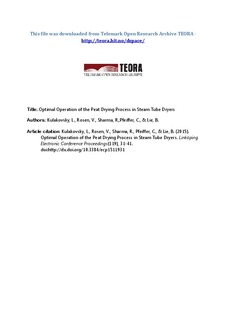| dc.contributor.author | Kulakovsky, Leonid | |
| dc.contributor.author | Rosen, Victor | |
| dc.contributor.author | Sharma, Roshan | |
| dc.contributor.author | Pfeiffer, Carlos Fernando | |
| dc.contributor.author | Lie, Bernt | |
| dc.date.accessioned | 2016-03-16T08:55:29Z | |
| dc.date.accessioned | 2017-04-19T12:50:09Z | |
| dc.date.available | 2016-03-16T08:55:29Z | |
| dc.date.available | 2017-04-19T12:50:09Z | |
| dc.date.issued | 2015-11-25 | |
| dc.identifier.citation | Kulakovsky, L., Rosen, V., Sharma, R., Pfeiffer, C., & Lie, B. (2015). Optimal Operation of the Peat Drying Process in Steam Tube Dryers. Paper presented at the 56th Conference on Simulation and Modelling (SIMS 56), October, 7-9, 2015, Linköping University, Sweden. | |
| dc.identifier.issn | 1650-3686 | |
| dc.identifier.uri | http://hdl.handle.net/11250/2438465 | |
| dc.description.abstract | Ukraine is an energy-dependent country and aims to reduce the import of natural gas, heat, and power in general. This implies extracting fuel from her own natural resources; one relevant and readily available energy carrier for such extraction is peat (bio mass). Currently, the operating regimes of the drying of peat are not energy efficient; these operating regime maps were developed in the 1970s and aimed only to get dry peat of required quality, without taking into account the cost of heat and electric energy in the drying process. The current quality of dried peat in the dryer does not always satisfy the necessary quality; e.g. parts of the peat may be insufficiently dried, or it may be over-dried. This affects the energy performance of peat briquette production. To improve the quality and energy efficiency of the peat drying process, an analysis of the drying process is carried out: an empirical mathematical model of the drying process is developed using the GMDH principle [1, 2, 3], mapping input parameters and disturbances to output qualities based on available experimental data. Next, with known (measured) disturbances, optimal input parameters for the drying process are found. Changing the operational parameters too fast leads to insufficient drying or over-drying of parts of the peat. Thus, to avoid changing the operational conditions too fast, the operational conditions are classified into a number of classes corresponding to a certain range of values for the operational parameters. Finally, an iterative procedure for changing the input parameters from the past values to new values is introduced. The resulting algorithm for finding the optimal operation of peat drying is based on mathematical models developed from experimental data, and aims to ensure improved quality and energy efficiency in the peat drying process. | |
| dc.language.iso | eng | |
| dc.publisher | Linköping University Electronic Press | |
| dc.subject | peat Drying | |
| dc.subject | steam tube dryers | |
| dc.subject | empirical model | |
| dc.subject | optimal operation | |
| dc.subject | group method of data handling | |
| dc.subject | regimes map | |
| dc.title | Optimal Operation of the Peat Drying Process in Steam Tube Dryers | |
| dc.type | Journal article | |
| dc.type | Peer reviewed | |
| dc.description.version | Published version | |
| dc.subject.nsi | 573 | |
| dc.source.journal | Linköping Electronic Conference Proceedings | |
| dc.identifier.doi | http://doi.org/10.3384/ecp1511931 | |
